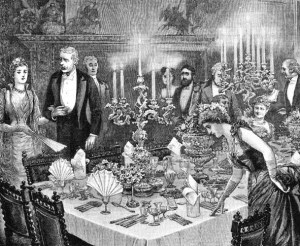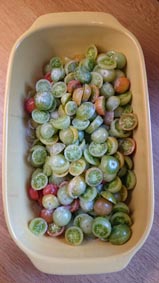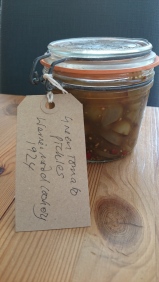I was asked to be on You and Yours on BBC Radio 4 last week, talking about so-called ‘food crimes’. Iceland had just announced a curry-filled Yorkshire Pudding, and there had been a spate of articles about the Tesco lasagne sandwich. Given the format of Y&Y, I was pitched, to some extent, against Nisha Katona, a chef from Liverpool, who is seeking to challenge the prevailing idea of curry as brown muck. We had a spirited discussion, mainly centred around notions of authenticity, and whether there is anything wrong with mixing up various cuisines and foodstuffs. I probably destroyed any credibility I might have had by admitting on air to consuming a spam and creme egg toastie, though I did point out I was drunk at the time. In fact, as my fellow consumer, now human rights and prison reform expert Anton Shelupanov pointed out, we also made a pork pie and creme egg toastie. He remembers the latter, I the former. My long-suffering other half suggests we made both, because we liked the first one so much. He also ate them. So there. (And they were weirdly compelling, for anyone wondering….but the goo which leaked out did necessitate the removal or my carpet and partial ruination of the toastie machine).
Anyway, if you are still reading and not retching, you, like me, may now be musing further. I think there are 3 main areas to ponder upon. Firstly, the idea that certain combinations or ideas are a ‘crime’, in the sense of being intrinsically wrong, mainly on grounds of good taste, but also, as Nisha pointed out, for health reasons. Secondly, the concept, which we discussed, that cooks should strive for authenticity in their creations, and not meddle with something which has tradition on its side. For me, there’s a further issue, which is that some of the various foods cited I wouldn’t eat because I suspect the quality is crap, and I wouldn’t like the end result regardless of what the actual combination was.
I shall come out and say straight away that I don’t believe in the R4 definition of a food crime. I don’t shriek with fear at the idea of lasagne sandwiches. Indeed, I have made lasagne pizza and indeed, risotto pizza and pommes dauphinoises pizza and, apart from a massive overload of carbs and starch, and the fact that I don’t actually like risotto, they were pretty good. The combinations might be ‘weird’ or out of the norm, but nothing in that statement makes them intrinsically wrong, tasteless or something anyone should avoid. After all, how does food evolve, if not for people trying stuff out? There are plenty of combinations in historic food which people today would look askance at: meat in mincemeat, caramelised sugar on top of a savoury fish custard, cheese ice cream etc etc. I’ve eaten all of these, and they are all delicious – but only once you accept that most notions of edibility are as culturally contrived as pretty much everything else in life. (Obviously there are exceptions, and most of them are universal, such as not eating as carrion eaters, or putrefied meat. But in terms of flavour combinations – anything goes).
The health argument carries more weight. I entirely agree with Nisha on the general principle that some of the foods that were cited are not those which a sane and health-loving person would necessarily choose to eat. But here we veer, surely, into a different set of arguments, centred around quality, mass production, and processing of food on the one hand, and the rather vexing question of what is actually good for us on the other. (And, indeed, whether being told what we can and cannot eat by a wide range of people is entirely acceptable or desirable – especially given the often contradictory advice which we seem to be given.) Nisha used the example of fat- and cream- laden curries, entirely removed from curry in the Far East, and a habit which debases what is, at is essence, a fairly healthy set of foods. I don’t disagree, in principle, but I think we should recognise that if someone likes a fat and cream-laden curry, then that is not a crime against taste. Let’s face it, if they aren’t suffering health issues, and don’t plan to eat one every day, it’s not exactly a taste issue either. I have concerns over dictating what ‘should’ be in a dish, or what the ‘rules’ of any form of culinary endeavour are. It’s the best way to render a cuisine moribund that I know.
Which brings me to authenticity. I think authentic is a very dangerous concept. What is authentic? Where do we put our stick in the ground? On air, I suggested that claiming all curries should strive for authenticity by the removal of modern ingredients and methods was unhelpful and simplistic: where do you take your curry back to? What is ancient? What is traditional? Because if you head back prior to the 16th century, the purist wouldn’t be able to include potatoes, tomatoes, or chillis, all new world ingredients introduced to India by the Portugese and Spanish, in the first instance. And, presumably, we’d also dismiss as inauthentic a whole range of Anglo-Indian adaptations of curry from the 18th and 19th century (oh, and lose the word curry as a generic and useful describing term itself). I should probably admit that most of these dishes aren’t cooked anymore, and that my fellow Kitchen Cabinetist and fab Scottish-Indian chef Angela Malik blanches whenever I bring one in. But that doesn’t mean they aren’t delicious (or healthy), and even Angela is prepared to admit she can see where and why the adaptations were made (apple or melon for mango and tamarind etc). We’ve argued the toss a lot, and I agree that the dishes are of their time, while still enjoying them. (I also enjoy her creations, which are completely different!)
So where does that leave us? Embracing the foods the media sniff at? Well, why not. The issues here are much more complex than they’d first appear, and cover more ground than a 2 minute slot as light relief in a lunchtime radio programme can do justice to. I have mused, but drawn few conclusions. I do recommend a processed meat and creme egg toastie though. Kind of.






